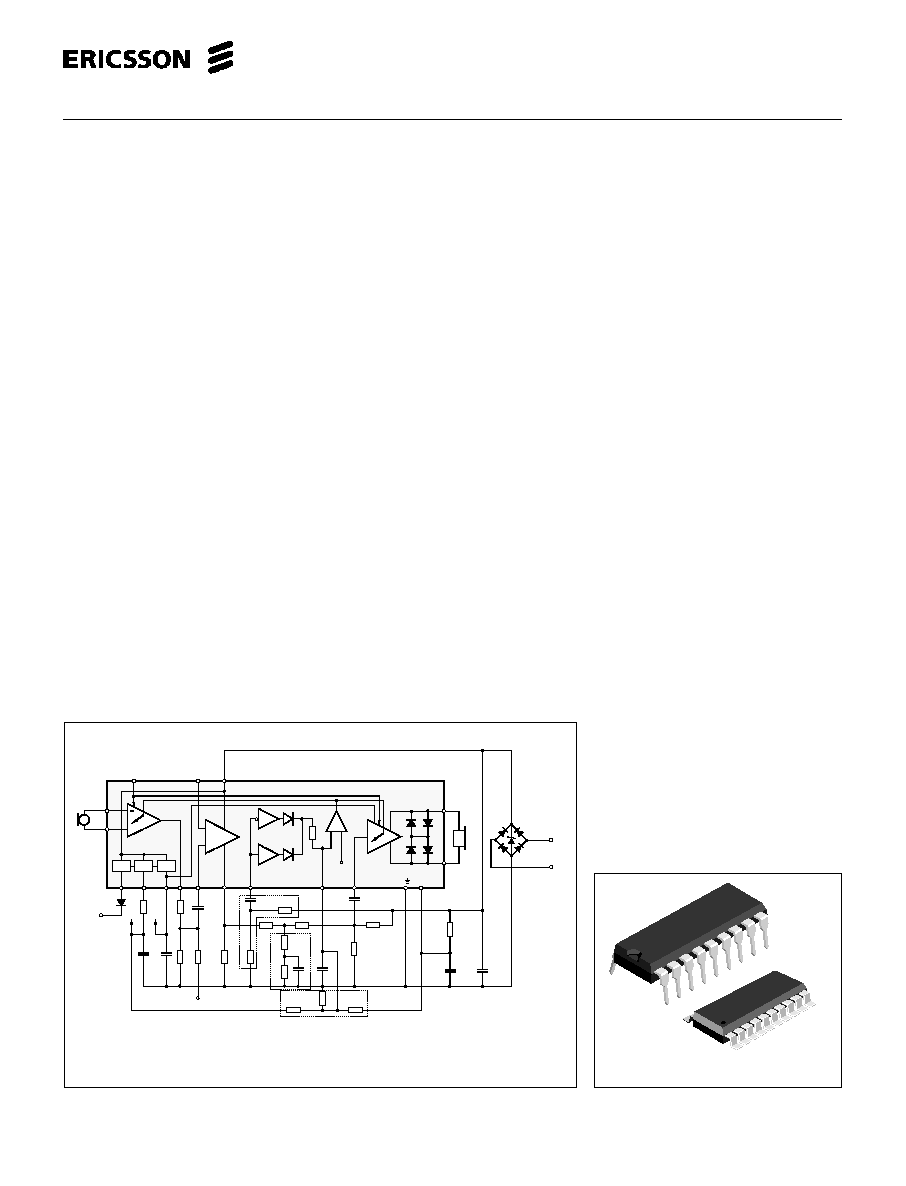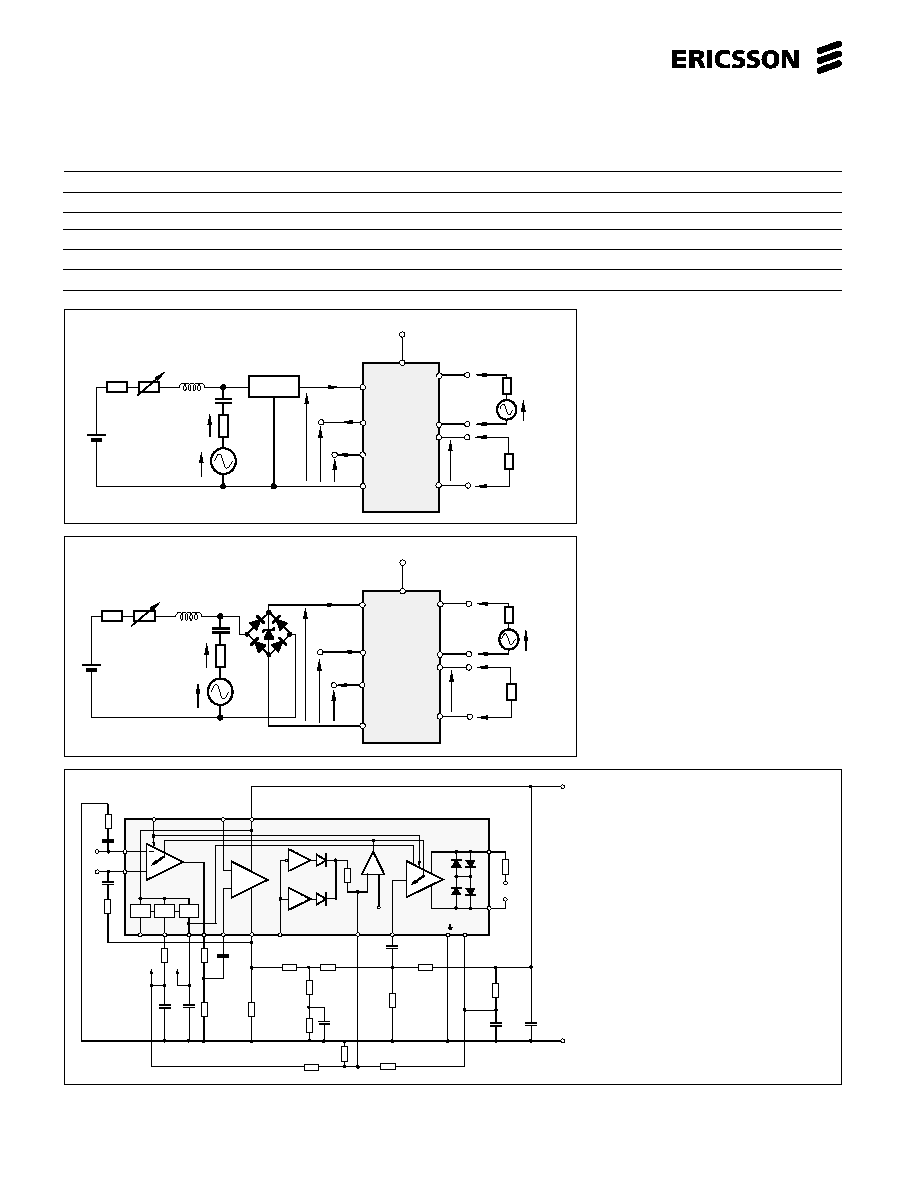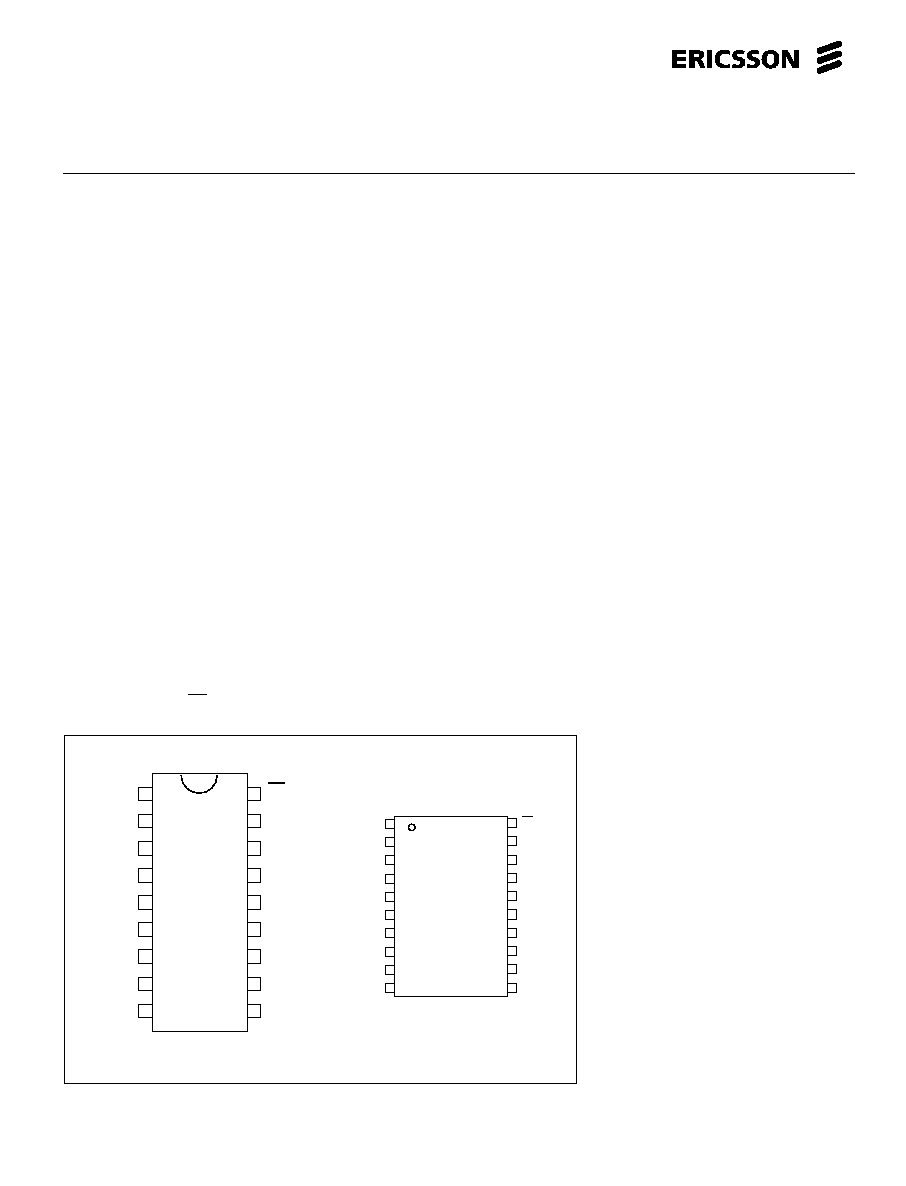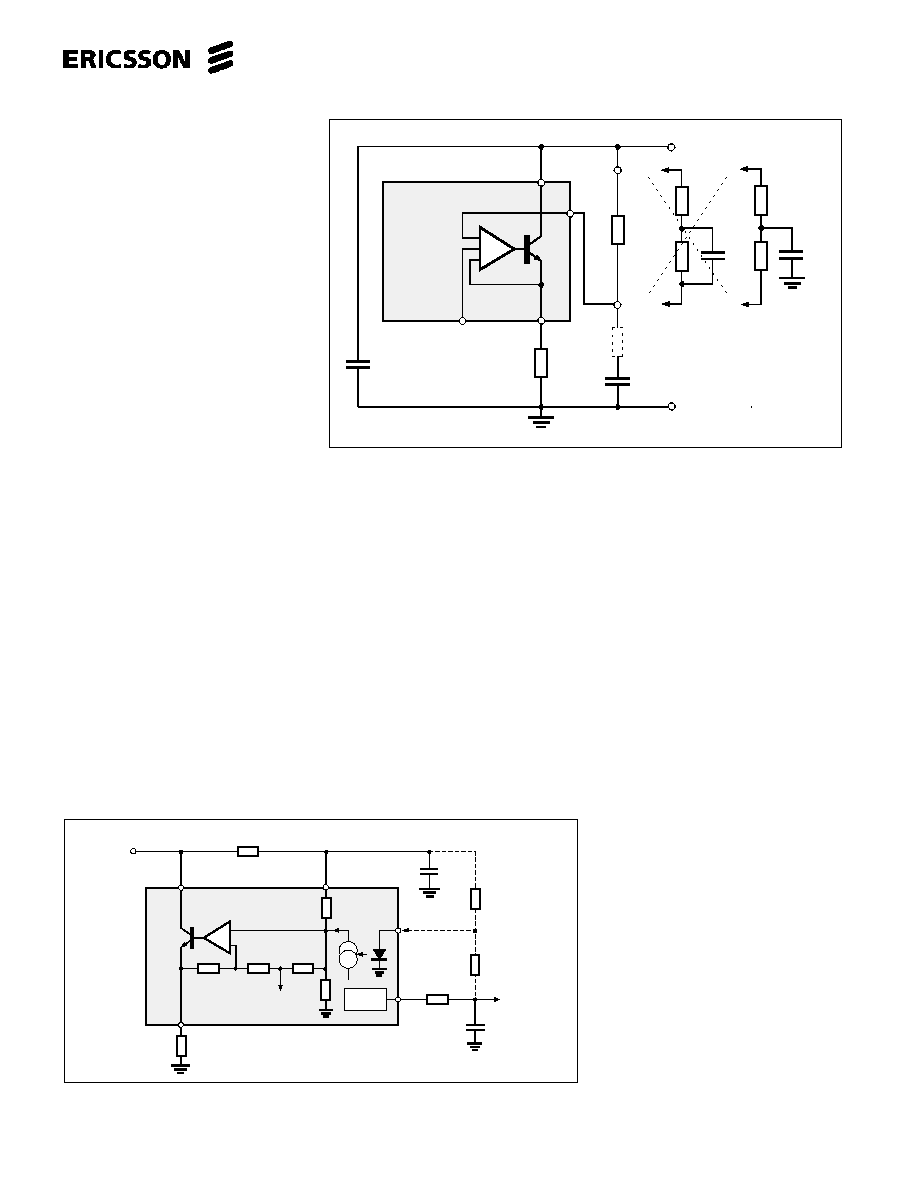 | –≠–ª–µ–∫—Ç—Ä–æ–Ω–Ω—ã–π –∫–æ–º–ø–æ–Ω–µ–Ω—Ç: PBL3852 | –°–∫–∞—á–∞—Ç—å:  PDF PDF  ZIP ZIP |

1
PBL 3852
PBL 3852
Universal Transmission Circuit
Figure 1. Functional diagram.
April 1996
18-pin plastic DIP 20-pin plastic SO
Key Features
∑
Generates its own supply from the
telephone line
∑
Adaptive to all types of telephone line
feeding systems (i.e. 48V 2x200
,
60V 2x 600
, 48V 2x800
)
∑
Operates down to 2.1V (excl. polarity
bridge)
∑
Adjustable DC-characteristic to the line
∑
Few inexpensive external components
to function
∑
Easy adaptation for various market
needs
∑
Dialler interface with DC-supply, mute,
power -down and DTMF-input
∑
Confidence tone in the receiver at
DTMF-dialling
∑
"Soft clipping" that prevents distortion
at high transmit signal levels
∑
Balanced microphone input for dyna-
mic, and electret microphones
∑
Balanced receiver output for dynamic
and magnetic receiver elements
∑
Transmitter and receiver gain regula-
tion for automatic loop loss compen-
sation (disabled in mute mode)
∑
Four separate DC supplies for different
requirements
∑
High gain of the receiver facilitates
volume control function
∑
Microphone cut-off function possible
by a switch
∑
All gain and frequency setting networks
in Rx, Tx and side tone are referred to
ground
∑
Excellent RFI performance
Description
The PBL 3852 is an universal transmission circuit in bipolar technology that performs
all the speech and line interface functions required to implement an electronic
telephone set suitable for the majority of existing telephone network requirements.
Easy adaptation of the DC-mask to different line feed systems. A summing point
for auxiliary signals to be transmitted like DTMF and hands-free audio signal. The
PBL 3852 has a low current consumption that enables the circuit to work with
reduced performance down to 2.1 volts (4.8 mA) across the circuit. The low current
consumption for a speech circuit is essential in telephone line powered handsfree
designs required to work at long line lengths. The PBL 3852 is especially suitable to
be used with Ericsson handsfree circuits like PBL 3786, PBL 3786/2, PBL 3881 and
PBL 3880 thanks to a specific interfacing arrangement.
The transmitting and receiving gains can be regulated in order to compensate for
the attenuation of the signals due to increasing attenuation with increasing line length.
It is also possible to limit high transmitting signal levels (soft clipping) thus preventing
excessive distortion caused by signal clipping. The gain regulation is set with discrete
external components.
The circuit is easily adapted to different markets by setting the application depend-
ent parameters individually in certain order, this preventing the interaction between
the same. PBL 3852 has up to four different power supplies to feed microphones,
auxiliary circuits and functions.
All pin numbers in this paper refer to DIP package.
PBL3852
PBL3852
13
(+Line)
(-Line)
Telephone
line
11
3
2
7
10
15
4 +
16
17
1
5
PBL 3852
6
C. Gain regulation with line length
12
+
18
9
8
Ref.
DC
supply
DC
supply
14
Ref.
DTMF
DC1
DC2
C.
B.
A.
A. Dynamic limiter
B. Sidetone network
+
+
+
+
+
+
-
Power
down

2
PBL 3852
Line voltage, T
p
= 2 s
V
L
0
22
V
Line current, continuous DIP
I
L
0
130
mA
Line current, continuous SO package
I
L
0
100
mA
Operating temperature range
T
Amb
-40
+75
∞
C
Storage temperature range
T
Stg
-55
+125
∞
C
Input level (all inputs)
0
+C
V
Maximum Ratings
Parameter
Symbol
Min
Max
Unit
Figure 4. Reference figure with line length regulation. (Application for dynamic microphone)
R1 = -
C1 = -
R2 = -
C2 = 47
µ
F
R3 = 100
C3 = 47
µ
F
R4 = 7.5k
C4 = 68nF
R5 = 33k
C5 = -
R6 = -
C6 = 100nF
R7 = 75
C7 = -
R8 = -
C8 = 47nF
R9 = 620
C9 = 47
µ
F
R10 = -
C10 = 15nF
R11 = 6.2k
C11 = -
R12 = 130
C12 = 0.15
µ
F
R13 = 2.4k
C13 = 0.15
µ
F
R14 = 27k
R15 = 18k
R16 = 120k
R17 = 18k
R18 = 62k
R19 = 910
R20 = -
R21 = -
R22 = 10k
R23 = 10k
R24 = 150
Figure 3. Test set up with rectifier bridge.
Figure 2. Test set up without rectifier
bridge.
+
= 150
+ LINE
- LINE
ARTIFICIAL
LINE
I L
V
2
V1
V
L
5H+5H
R = 0-4K
L
0 ohm when artificial
line is used
MUTE
PBL 3852
with external
components
See fig. 4
Z
Mic = 150
Z
Rec
MIC
REC
R
feed = 400
+400
600
C
E= 48.5V
V 3
V4
I
DC1
C = 1
µ
F when artificial line is used
470
µ
F when no artificial line
V
M
DC2
I
V
DC1
V
DC2
+
+
= 150
+ LINE
- LINE
I
L
V
2
V
1
V
L
5H+5H
R = 0-4K
L
MUTE
PBL 3854
with external
components
See fig. 4
Z
Mic = 150
Z
Rec
MIC
REC
R
feed = 400
+400
600
+
E = 48.5V
V
3
V
4
1
µ
F
I
DC1
V
M
DC2
I
V
DC1
V
DC2
Uz= 15-16V
13
Mute
(+Line)
(-Line)
11
3
2
7
10
15
4 +
16
17
1
5
PBL 3852
6
12
+
18
9
8
Ref.
DC
supply
DC
supply
14
Ref.
DC1
DC2
+
+
+
MIC
REC
R22
R23
C12
C13
R3
R4
R5
R7
R9
R11
R12
R13
C4
C2
C3
C6
C8
R14
R15
R16
R17
R18
R19
C9
C10
+
+
-
+C
R24

3
PBL 3852
Electrical Characteristics
At T
Amb
= + 25
∞
C. No cable and no line rectifier unless otherwise specified.
Parameter
fig.
Conditions
Min
Typ
Max
Unit
Line voltage, V
L
note 1
2
I
L
= 15 mA
3.3
3.7
4.1
V
2
I
L
= 100 mA
11
13
15
V
Transmitting gain, note 1
20 ∑
10
log (V
2
/ V
3
); 1 kHz
2
R
L
= 0
41
43
45
dB
2
R
L
= 400
43.5
45.5
47.5
dB
2
R
L
= 900
- 2200
46
48
50
dB
Transmitting range of
2
1 kHz, R
L
= 0 to 900 ohm
3
5
7
dB
regulation
note 1
Transmitting frequency
2
200 Hz to 3.4 kHz relative to 1 kHz
-1
1
dB
response
Receiving gain, note 1
20 ∑
10
log (V
4
/ V
1
); 1 kHz
2
R
L
= 0
-13
-11
-9
dB
2
R
L
= 400
-10.5
-8.5
-6.5
dB
2
R
L
= 900
- 2200
-8
-6
-4
dB
Receiving range of regulation
2
1 kHz, R
L
= 0 to 900
3
5
7
dB
Receiving frequency response 2
200 Hz to 3.4 kHz relative to 1kHz
-1
1
dB
Microphone input impedance
2
1 kHz,
1.7
k
pin 12 (14),13 (15)
Transmitter input impedance
2
1 kHz
17
k
pin 3
Transmitter dynamic output
2
200 Hz - 3.4 kHz
1.5
V
p
2% distortion, I
L
= 20 - 100 mA
Transmitter max. output
2
200 Hz - 3.4 kHz
3
V
p
I
L
= 0 - 100 mA, V
3
= 0 - 1 V
Receiver output impedance
2
1 kHz, R
L
= 0
, note 4
32(+150)
Receiver dynamic output
2
200 Hz - 3.4 kHz
0.5
V
p
2% distortion, I
L
= 20 - 100 mA
Receiver max. output
3
Measured with line rectifier
0.9
V
p
200 Hz - 3.4 kHz, I
L
= 0 - 100 mA
V
1
= 0 - 50 V
Transmitter output noise
2
Psoph-weighting, Rel 1 V
rms
, R
L
= 0
-75
dB
Psoph
Receiver output noise
2
A-weighting, Rel 1V
rms
, with cable
-80
dB
A
0 - 5 km, ¯ = 0.5 mm note 3
0 - 3 km, ¯ = 0.4 mm
Mute input current
2
20
µ
A
DC1-supply voltage
2
I
L
= (20 - 100) mA note 2
1.75
2.0
2.25
V
I
DC1
= 1 mA
DC2-supply voltaget (clamp)
2
I
L
= 20-100 mA see text, I
DC2
= 1.9 mA note 2
3.4
3.7
4.0
V
at zero signal in the receiver amplifier
Notes
1. Adjustable to both higher and lower values with external components.
2. Lowest line current dependent of the set DC-characteristic. See page 14, fig 8.
3. Psofometric weighting will give (6-7) dB lower value. (-dB)
4. 150 ohm resistor in test set up.
Ref.

4
PBL 3852
Pin Description
DIP
SO
Symbol
Description
1
1
+L
Positive line terminal
2
2
TO
Slope setting for DC characteristic and sidetone balancing signal output
3
3
TI
Transmitter amplifier input
4
4
+C
Internal power supply
5
5
DCC
Line voltage DC level adjustment input
6
6
MUTE
Transmitter and receiver amplifier mute input
7
7
RCT
Dynamic limiter "soft clipping" input
8
8
DC2
DC supply 2 output, typically 3.7 V
9
9
DC1
DC supply 1 output, typically 2.1 V
10
NC
Not connected
11
NC
Not connected
10
12
GR
The output of the rectifier to the dynamic limiter and gain regulation input
11
13
MO
Microphone amplifier output
12
14
MI1
Microphone amplifier non-inverting input
13
15
MI2
Microphone amplifier inverting input
14
16
-L
Negative line terminal
15
17
RI
Receiver amplifier input
16
18
RO1
Receiver amplifier inverting output
17
19
RO2
Receiver amplifier non-inverting output
18
20
PD
Power down input
Figure 5. Pin configuration.
DIP
SO
+L
TO
TI
+C
DCC
Mute
RCT
DC2
RO1
RI
-L
MI 2
MI 1
MO
1
2
3
4
5
6
7
8
16
15
14
13
12
11
DC1
GR
9
10
PD
RO2
18
17
1
2
3
4
5
6
7
8
20
19
18
17
16
15
14
13
+L
TO
TI
+C
DCC
Mute
RCT
DC2
PD
RO2
RO1
RI
-L
MI 2
MI 1
MO
9
12
10
11
DC1
NC
GR
NC

5
PBL 3852
Functional Description
Design procedure
1. Set the circuit impedance to the line,
either 600
or complex. (R19 and C9).
C9 should be big enough to give low
impedance compared with R19 in the
telephone speech frequency band.
Too large C9 will make the start-up
slow.
2. Set the DC-characteristic that is
required in the PTT specification or in
case of a system telephone in the PBX
specification (R7). There are also
internal circuit dependent requirements
like supply voltages etc.
3. Set the attac point where the line length
regulation is supposed to cut in
(R14,R15 and R16). Note that in some
countries the line length regulation is
not allowed. In most cases the
end result is better and more readily
achieved by using the line length
regulation (line loss compensation)
than without.
4. Set the transmitter gain, regulation and
frequency response. See text for the
dynamic limiting feature.
5. Set the receiver gain and frequency
response. See text how to limit the
max. swing to the earphone.
6. Adjust the side tone balancing network.
7. Set the RFI suppression components
in case necessary. In two piece
telephones the often "helically" wound
cord acts as an aerial where especially
the microphone input with its high gain
and input impedance is the more
sensitive.
Figure 7. System of DC-Characteristic.
Figure 6. AC-impedance.
signal entering pin 4 is set by the ratio
Rs/R19 (909
), where in case b) the
ratio at high frequency will be Rs/220
because the 820
resistor is bypassed by
a capacitor. To help up this situation the
complex network capacitor is connected
directly to ground, case c) making the
ratio Rs/220
+820
and thus lessening
the error signal. Conclusion: Use case c)
when complex impedance is specified.
DC - characteristic
The DC - characteristic that a telephone
set has to fulfill is mainly given by the
network administrator.Following para-
meters are useful to know when the DC
behaviour of the telephone is to be set:
∑ The voltage of the feeding system
∑ The line feeding resistance 2 x.... ohms
∑ The maximum current from the line at
zero line length
∑ The min. current at which the telephone
has to work (basic function)
∑ The lowest and highest voltage
permissible across the telephone set.
∑ The highest voltage that the telephone
may have at different line currents is
normally set by the network owners
specification. The lowest voltage for the
telephone is normally set by the
different voltages that are needed for
the different parts of the telephone. For
ex. for transmitter output amplifier,
receiver output amplifier, dialler,
speech switching and loudspeaker
amplifier in a handsfree telephone etc.
Impedance to the line
The AC- impedance to the line is set by
C10, R19 and C9. Fig. 6. The circuits
relatively high (
20k with R7 = 75
)
parallel impedance will influence it to
some extent. At low frequencies the
influence of the C9 can not be neglected.
Series resistance of the C9 that is
dependent on temperature and quality will
cause that some of the line signal will
enter pin 4 and generate a closed loop in
the transmitter amplifier that will create an
active impedance thus lowering the
impedance to the line. The impedance at
high frequencies is set by C10 that also
acts as a RFI suppressor.
In many specifications the impedance
towards the line is specified as a complex
network. See fig. 6. In case a) the error
1
2
+Line
R19
R7
PBL 3852
+
3
C9
C10
-Line
Rs
1
The complex network
220
+ 820
//115nF
Example:
a)
b)
c)
4
Ref=1.16V
I pin5
1
4
2
5
+Line
R19
R7
PBL 3852
-
+
C9
- I pin5
+
+
DC-
supply
9
R3
DC1
R21
R20
C2




